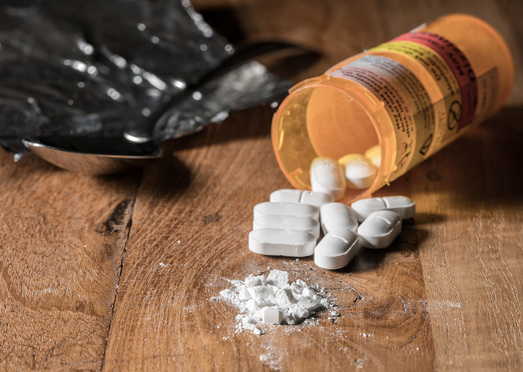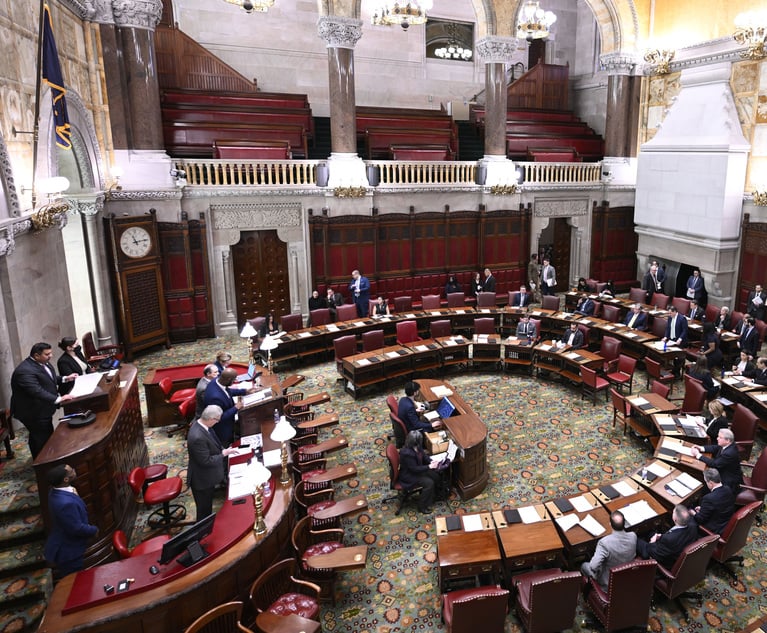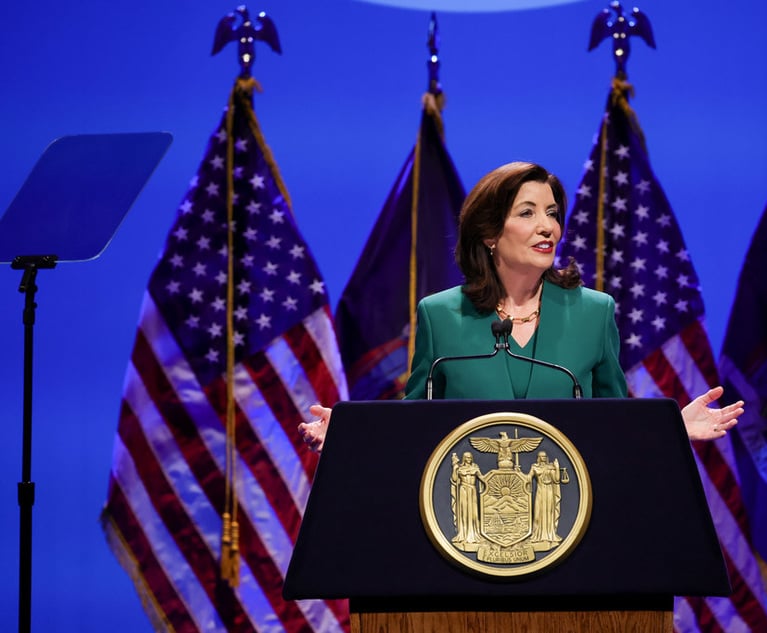NY Court of Appeals Eyes Homicide Charge Against Doctors Over Opioid Death
Li's defense counsel contested arguments by the Office of the Special Narcotics Prosecutor that the doctor didn't consider the medical history, or actual pain experienced, by his patients before he chose to prescribe them opioids.
October 17, 2019 at 03:43 PM
6 minute read

The New York Court of Appeals on Thursday heard arguments on whether doctors can face state homicide charges if the drugs they prescribe are used by a patient during a fatal overdose on the medication.
Dr. Stan XuHui Li, who practiced in Queens, is seeking to have his conviction on manslaughter charges for the overdose deaths of two of his patients overturned by New York's highest court.
Raymond Belair, of Belair & Evans in Manhattan, argued before the high court that Li couldn't have known that his patients would overdose. He also said the prescriptions were nonlethal if taken as directed.
"The medications that are involved in this homicide case were prescribed within regular therapeutic range, and which, if taken as prescribed, would never have caused death, and were incapable of causing death based on what my client, Dr. Lee, knew at the time," Belair said.
Li was convicted on charges of manslaughter—as well as 196 other charges—in 2014 over the deaths of two of his patients, Joseph Haeg and Nicholas Rappold.
Prosecutors from the New York City Office of the Special Narcotics Prosecutor had alleged that Li was essentially running what's known as a "pill mill," an office where the physician prescribes a disproportionate amount of addictive medications.
Li operated a pain management clinic in Flushing, Queens, for about seven years, from 2004 to his arrest on homicide charges in 2011. Prosecutors used the nature of the clinic's business to build their case against Li.
His clinic was only open one day a week, on the weekend, and didn't require appointments to be seen. Prosecutors said he saw as many as 90 patients in a single day and charged a base fee of $100 per visit. All payments were required to be made in cash.
Investigators from the Office of the Special Narcotics Prosecutor found that, over three years alone, Li had written more than 21,000 prescriptions for controlled substances. He charged patients more than the $100 base fee if they came to him before their prescription ran out.
The Manhattan District Attorney's Office is handling the appeal on behalf of the Office of the Special Narcotics Prosecutor.
Vincent Rivellese, who argued before the Court of Appeals on Thursday for the Manhattan District Attorney's Office, said Li was driven to write those prescriptions by the money they would generate from patients who continued to come back to him for those drugs.
"It was always about money," Rivellese said. "He even had signs in his office about how noncompliant behavior would be treated."
That incentive drove Li to either ignore, or choose not to address, signs that his patients were dependent on drugs and seeking prescriptions from his clinic to fuel their addiction, prosecutors alleged.
More than half of Li's prescriptions between 2008 until his arrest in 2011 were for the highly addictive opioid drug oxycodone. More than a quarter of his prescriptions during that time were for Xanax, which is also addictive.
When both of those drugs are taken together, they can impair an individual's breathing. Experts who testified for the Office of the Special Narcotics Prosecutor said the combination could be fatal.
Li was charged with two counts of second-degree manslaughter for the deaths of Haeg and Rappold, and was also brought up on counts of reckless endangerment, criminal sale of a prescription, fraud and others.
After his conviction on most of the charges, including manslaughter, Li was handed a combined sentence of 10 to 20 years in prison. The manslaughter charges, alone, accounted for five to 15 years of that sentence.
Li's defense counsel contested arguments by the Office of the Special Narcotics Prosecutor that the doctor didn't consider the medical history, or actual pain experienced, by his patients before he chose to prescribe them opioids.
In the case of the two patients who overdosed on his prescriptions, Haeg and Rappold, Li physically examined both and wrote them prescriptions within the guidelines of the U.S. Food and Drug Administration, he said.
"I urge you to look at these records," Belair said. "He performs a physical examination on both of these patients."
Associate Judge Eugene Fahey appeared skeptical of Belair's argument that Li was operating his clinic without any knowledge that his patients could be dealing with addiction or using his service to obtain drugs without a medical need for them.
Fahey pointed to the fact that Li only accepted cash at the clinic, for example, and that he charged patients more if they returned before their previous prescription was scheduled to run out.
"There were just a series of things in the record that seemed to establish the requisite conscious intent in this case under legal sufficiency and connect it to both Rappold and Haeg," Fahey said.
Fahey later questioned Rivellese, though, about how much discretion his office viewed prosecutors to have in bringing criminal charges related to an overdose on opioids. He asked if the same standard used against Li could be used against a pharmacist filling prescriptions for addictive drugs, or even a drug distributor or manufacturer.
"People aren't stupid, they recognize there's a pattern here," Fahey said. "Are they then eligible for criminal charges?"
Rivellese responded that each case would rely on the underlying evidence against those individuals and entities, including whether they had knowledge that those drugs could have been misused by patients.
"You're going to have to be able to convince a jury beyond a reasonable doubt that this person knew about the risks," Rivellese said.
The Court of Appeals will likely hand down a decision on the matter next month, or in December.
READ MORE:
NY High Court Grants New Trial in Case Where Prosecutors Withheld Witness Contact Info
NY High Court Eyes Doctors' Right to Sue Over Bad Faith Reports of Medical Misconduct
Court of Appeals Weighs Liability for Out-of-Possession Landlords in Sidewalk Injury Claims
NY High Court to Decide Future of One-Mile Stretch of Road in Adirondacks
This content has been archived. It is available through our partners, LexisNexis® and Bloomberg Law.
To view this content, please continue to their sites.
Not a Lexis Subscriber?
Subscribe Now
Not a Bloomberg Law Subscriber?
Subscribe Now
NOT FOR REPRINT
© 2025 ALM Global, LLC, All Rights Reserved. Request academic re-use from www.copyright.com. All other uses, submit a request to [email protected]. For more information visit Asset & Logo Licensing.
You Might Like
View All
Relaxing Penalties on Discovery Noncompliance Allows Criminal Cases to Get Decided on Merit
5 minute read
Bipartisan Lawmakers to Hochul Urge Greater Student Loan Forgiveness for Public-Interest Lawyers

'Playing the Clock'?: Hochul Says NY's Discovery Loophole Is to Blame for Wide Dismissal of Criminal Cases

So Who Won? Congestion Pricing Ruling Leaves Both Sides Claiming Victory, Attorneys Seeking Clarification
4 minute readTrending Stories
Who Got The Work
J. Brugh Lower of Gibbons has entered an appearance for industrial equipment supplier Devco Corporation in a pending trademark infringement lawsuit. The suit, accusing the defendant of selling knock-off Graco products, was filed Dec. 18 in New Jersey District Court by Rivkin Radler on behalf of Graco Inc. and Graco Minnesota. The case, assigned to U.S. District Judge Zahid N. Quraishi, is 3:24-cv-11294, Graco Inc. et al v. Devco Corporation.
Who Got The Work
Rebecca Maller-Stein and Kent A. Yalowitz of Arnold & Porter Kaye Scholer have entered their appearances for Hanaco Venture Capital and its executives, Lior Prosor and David Frankel, in a pending securities lawsuit. The action, filed on Dec. 24 in New York Southern District Court by Zell, Aron & Co. on behalf of Goldeneye Advisors, accuses the defendants of negligently and fraudulently managing the plaintiff's $1 million investment. The case, assigned to U.S. District Judge Vernon S. Broderick, is 1:24-cv-09918, Goldeneye Advisors, LLC v. Hanaco Venture Capital, Ltd. et al.
Who Got The Work
Attorneys from A&O Shearman has stepped in as defense counsel for Toronto-Dominion Bank and other defendants in a pending securities class action. The suit, filed Dec. 11 in New York Southern District Court by Bleichmar Fonti & Auld, accuses the defendants of concealing the bank's 'pervasive' deficiencies in regards to its compliance with the Bank Secrecy Act and the quality of its anti-money laundering controls. The case, assigned to U.S. District Judge Arun Subramanian, is 1:24-cv-09445, Gonzalez v. The Toronto-Dominion Bank et al.
Who Got The Work
Crown Castle International, a Pennsylvania company providing shared communications infrastructure, has turned to Luke D. Wolf of Gordon Rees Scully Mansukhani to fend off a pending breach-of-contract lawsuit. The court action, filed Nov. 25 in Michigan Eastern District Court by Hooper Hathaway PC on behalf of The Town Residences LLC, accuses Crown Castle of failing to transfer approximately $30,000 in utility payments from T-Mobile in breach of a roof-top lease and assignment agreement. The case, assigned to U.S. District Judge Susan K. Declercq, is 2:24-cv-13131, The Town Residences LLC v. T-Mobile US, Inc. et al.
Who Got The Work
Wilfred P. Coronato and Daniel M. Schwartz of McCarter & English have stepped in as defense counsel to Electrolux Home Products Inc. in a pending product liability lawsuit. The court action, filed Nov. 26 in New York Eastern District Court by Poulos Lopiccolo PC and Nagel Rice LLP on behalf of David Stern, alleges that the defendant's refrigerators’ drawers and shelving repeatedly break and fall apart within months after purchase. The case, assigned to U.S. District Judge Joan M. Azrack, is 2:24-cv-08204, Stern v. Electrolux Home Products, Inc.
Featured Firms
Law Offices of Gary Martin Hays & Associates, P.C.
(470) 294-1674
Law Offices of Mark E. Salomone
(857) 444-6468
Smith & Hassler
(713) 739-1250






